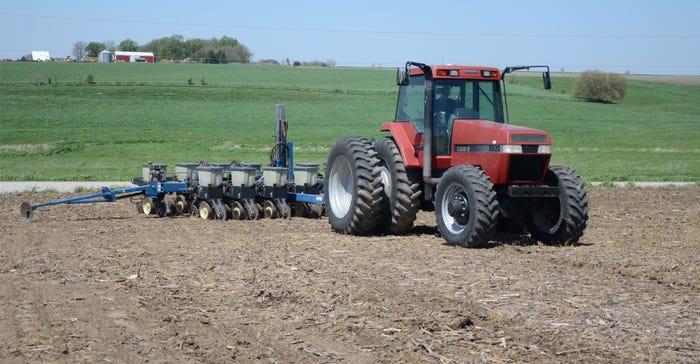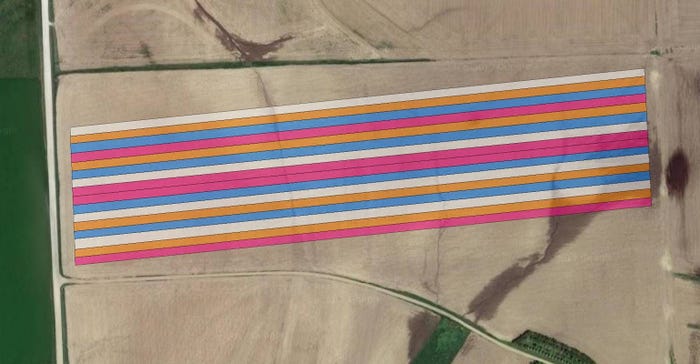
On a warm, windy day in Washington County, Nathan Mueller plants a magenta-colored flag, marked "90,000" on the edge of a field where his dad, Larry, recently started planting soybeans. It's the first of several soybean fields the Muellers are planting this spring, but this one was specifically chosen for a research trial with the Nebraska On-Farm Research Network.
Over the last 10 years, trial data from the University of Nebraska-Lincoln On-Farm Research Network has shown that soybean growers can cut back on their planting populations when planting on 30-inch rows without hurting soybean yields. And although planting populations have been trending downward, Nathan, Nebraska Extension educator in Dodge and Washington counties, adds recent surveys of over 900 Nebraska producers from 2014 to show there is still room for improvement.
"The bulk [about 90%] of respondents were planting between 135,000 and 175,000 plants per acre," he says. "Our current recommendation is to get 100,000 plants in the field. Roughly 85% of what you plant will make up the plant population, so we typically recommend planting 120,000 seeds per acre. Growers err on the side of seeding higher as an insurance policy. I think the concern growers have is that with 120,000 seeds per acre, there's not much of a buffer. But with 100,000 plants, we're still probably being fairly conservative. With 120,000 seeds, there's still a 30,000 seed buffer in some cases."
More data needed
However, as Nathan notes, most of those trials have been for 30-inch rows. "Everybody has moved to planters from drills, and we just don't have as much data for 15-inch rows," he says. "Are the results for 30-inch rows going to be the same for 15s? In the past, most of the seeding rates were in 30-inch rows or with narrow row drills. We don't have much data on 15-inch rows on planters, and we don't have much data north of the Platte River. Our assumption is there isn't going to be a big difference, but there is interest regionally to collect more data."
There's also the question of the optimal seeding rate for northeast Nebraska. Is 120,000 still appropriate to reach the ideal plant population of 100,000? In Iowa, for example, recommendations are to plant 125,000 to 140,000 seeds per acre for a final stand of 100,000. Keep in mind that Iowa's northern tiers are farther north than Nebraska, and these numbers may be a good fit for northeast Nebraska's cooler environment.
So, over the last two years, Nathan and Larry have been trialing different soybean populations on 15-inch rows on Larry's farm in Washington County, including 90,000, 120,000, 150,000 and 180,000 seeds per acre.
Larry has planted 15-inch soybeans using a Kinze 2500 15-row, split-row planter for six years. Prior to last year, he notes he had mostly used planting populations from 145,000 to 168,000 on his narrow-row beans.
"I had been planting around 168,000, 155,000 to 145,000. I thought there might be a little difference in yield, but thinner stands performed just as well," says Larry. "I'm curious to see how it does this year."
"Last year, all of the seeding rates — even 90,000 — they all yielded within a bushel of each other, which isn't statistically significant," adds Nathan. "The recommendation isn't to seed 90,000. But quite often, the 90,000 population yields just as high as the other populations."
Harvesting benefits of narrow rows
In the last six years, Larry also realized the benefits of 15-inch rows. To capture the full benefit of photosynthesis, Extension recommends planting soybeans earlier — around April 25. This gives soybeans a chance to reach full canopy by the peak sunlight period around June 21, which means greater yield potential. However, narrow-row soybeans can also help reach canopy closure faster.
"Planting narrow rows takes an investment in a second planter. With 30-inch rows, you could use the same planter you used for your corn," notes Larry. "But if you want to realize the benefit of planting earlier in soybeans every year, you need a second planter, because you're not quite done with corn when you should be planting beans. If you're going to have a second planter, it only makes sense to go to narrow rows. Canopy closure occurs sooner than with 30-inch rows, and you get additional weed suppression."

AERIAL VIEW: This aerial map of the research plot on Larry Mueller's farm shows the different planting populations being tested. In this study, blue stands for 180,000 seeds per acre; white is the control at 150,000; orange is 120,000 and pink is 90,000. The populations are also marked with color-coded flags at the ends of each row.

Studies conducted in 2016 on conventional soybeans through the Nebraska On-Farm Research Network also demonstrated significant yield increases with 15-inch-row soybeans in two out of four sites, while narrow rows combined with preemergence followed by a postemergence herbicide program resulted in higher yields and better weed control in conventional soybeans.
From 2009 to 2011, the United Soybean Board conducted its "The Kitchen Sink Project" in six states: Arkansas, Iowa, Kentucky, Louisiana, Michigan and Minnesota. The project evaluated the yield impact of different inputs and agronomic practices, essentially throwing the "kitchen sink" at the crop.
Nathan notes of the all the variables tested, the most consistent benefit to yield was narrow rows — in the case of this study, 20-inch rows, which yielded 2.9 bushels per acre more on average than 30s. "On average, it's a 3-bushel improvement. But depending on the year, it could be 9 bushels, or it could be zero," he says. "The average is 3 bushels, but it won't be that from year to year. Narrow rows generally never yielded less; they generally yielded the same as 30-inch rows or better."
About the Author(s)
You May Also Like






